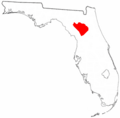Cades Pond culture facts for kids
The Cades Pond culture was a group of people who lived in north-central Florida a long time ago, between about 100 and 600 CE. They were part of what archaeologists call the Middle Woodland period.
Where They Lived
The Cades Pond people lived in an area that is now central and eastern Alachua County, northern Marion County, and parts of Bradford County and Putnam County. They always built their villages close to big lakes or rivers, usually within 2 kilometers (about 1.2 miles) of water.
Many of their villages were grouped together between large lakes. Some were also found along the Santa Fe River. Experts have found several main groups of villages and large mounds. For example, there were clusters near Paynes Prairie and Newnans Lake, and between Orange Lake and Lochloosa Lake.
The name "Cades Pond culture" comes from the Cades Pond Mound. This mound is in southeastern Bradford County and was first studied in the 1870s.
These people built many mounds. Before farming and building changed the land, there might have been over 50 mounds in Alachua County, and most were likely built by the Cades Pond people. Villages and mounds were usually found together. Important villages, which were like their community centers, might have had several mounds, burial grounds, other earthworks, or even ponds. Smaller settlements might not have had a mound. These villages were lived in for a long time and had big pits for storing food.
Their History
Before the Cades Pond culture began, people from the Deptford culture lived in the area. They mostly stayed near the Gulf of Mexico coast but visited inland spots during certain seasons. Around 100 CE, the Deptford people started building permanent villages in Alachua County, and this is when the Cades Pond culture began to form from the Deptford culture.
Some of the earliest Cades Pond sites, like River Styx and Cross Creek, had special horseshoe-shaped mounds or earthworks. These earthworks often surrounded a central mound used for burials. The River Styx site is the oldest known Cades Pond site. It shows a mix of old Deptford styles and new Cades Pond styles. Most burials at River Styx were cremations, which was rare at other Cades Pond sites later on.
The Cross Creek site came a bit later and was more complex, with several mounds. It didn't have the older Deptford pottery styles.
Around 300 CE, new types of fancy pottery from the Weeden Island culture started appearing in Cades Pond mounds. However, most of the everyday pottery found in Cades Pond villages was plain and looked like pottery from the nearby St. Johns culture. This suggests they had strong connections with the St. Johns people.
Around 600 to 700 CE, the Cades Pond culture was replaced by the Alachua culture. Some experts think a long period of dry weather (drought) in north-central Florida around 659 to 724 CE might have caused this change. The Alachua culture had simpler rituals and mounds. They also focused more on living in upland areas, unlike the Cades Pond people who relied heavily on wetlands.
There are different ideas about how the Alachua culture took over:
- Maybe the Cades Pond people slowly changed into the Alachua culture, adopting new pottery styles from groups further north.
- Perhaps the Alachua people moved into the area and lived alongside the Cades Pond people for a while, eventually blending with them.
- It's also possible that the Cades Pond people left the area or disappeared before the Alachua people arrived.
Their Daily Life
The Cades Pond culture is known for its unique pottery and stone tools, and for where they chose to build their villages. Most of their pottery was made of large, plain bowls.
They used many different kinds of tools:
- Stone tools: Knives, scraping tools, tools for making holes (perforators), and grinding stones (like manos and metates).
- Bone tools: Tools for fishing (leisters), sewing (awls), making holes, and scraping. Many were made from deer bones.
- Shell tools: Tools made from the strong central part of conch or whelk shells.
- Shark's teeth: Used as tools.
The Cades Pond people were very good at using the resources from their watery environment. At one site, called Melton, about 85% of the animals they ate came from water habitats. This included:
- Snails and clams
- Many types of fish
- Frogs
- Seven types of turtles
- Water snakes
- Alligators
- Water birds
- Otters and muskrats
They also hunted land animals like deer, black bear, panther, opossum, rabbits, squirrels, skunks, rats, and foxes.
For plants, they ate hickory nuts, pine nuts, acorns, Chickasaw plum, persimmon, and wild cherry. There is no clear proof that the Cades Pond people grew their own crops. Their pottery suggests they often boiled or cooked food with water.
They also traded with other cultures. Pottery from the St. Johns culture shows they had connections with people living in the St. Johns River valley. Evidence of trade with people from the Gulf and Atlantic coasts includes remains of different types of shark, sea turtles, mullet, and marine mollusks. They also got materials like slate, greenstone, and copper from far away, as these are not found in Florida.
While there's no direct archaeological proof of them growing corn (maize), studies of human bones from Cades Pond sites suggest that corn became a bigger part of their diet over time.
Images for kids


